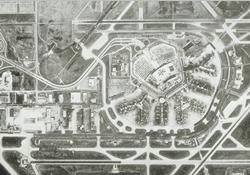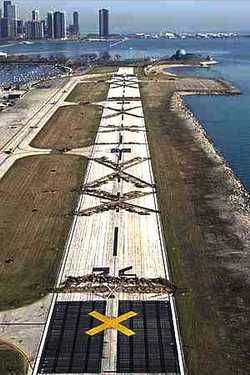Nobody Official Would Look at it, Anyway...
For five months, the Chicago-area controllers were trying to
have their idea for the O'Hare expansion plan heard, and nobody was
listening. The ATC-ers were concerned, specifically, about the
proposed new east-west runway, planned for the south end of the
airport. They maintained that its orientation was suboptimal;
reporters call that condition, 'dangerous.'
Northwest-southeast, they said, would be better, considering
traffic patterns and most-common wind direction.

The controllers were part of an FAA team to look at O'Hare
proposals, but it said their ideas were systematically ignored by
the city's Department of Aviation. So, the controllers went to the
media earlier this week, with their concerns, and their plan. The
Department of Aviation is now, reportedly, quite interested.
The controllers' plan addresses more than just prevailing winds,
and promises a reduction in the occasion for runway incursions,
potentially deadly at the high-traffic hub, notorious for having
all four seasons of weather -- sometimes separated by mere
hours. Runway crossings, according to a Tribune article,
"would be cut by up to 480 a day." Additional good news would be a
reduction in taxi time by an average of at least five minutes,
for each of the giant jet-A guzzlers that used the proposed
route.
ANN Interviews ATC Association President
 ANN called Craig Burzych, President of ATC
association at O'Hare.
ANN called Craig Burzych, President of ATC
association at O'Hare.
He brought us up to speed: "The Daley departure runway
(10R, at 7500 feet) wouldn't be something we'd assign too many
airplanes to; the alternative, 12-30, could be a minimum of
9000 feet, probably 10,000; and these airplanes wouldn't have to
cross the other runways."
Controllers looked at the current airport layout, and noticed
that "...when the wind was out of the west, the airport was
efficient; it was safer -- there were fewer runway crossings
involved. When the wind was out of the East, we couldn't depart as
many aircraft as we could land. We couldn't keep up, on the
departure side."
 Drawing on experience, and looking at traffic
patterns on the ground, Bill Spencer (18 years as a
controller at O'Hare alone) and Kevin Markwell (ops
manager and former controller, who, we're told, is still current)
thought through what was going on. Craig continued, "This proposed
runway (12-30) is a near-mirror-image of the existing 22R. It
allows us to get a better departure issue during east winds -- and
it's so much safer."
Drawing on experience, and looking at traffic
patterns on the ground, Bill Spencer (18 years as a
controller at O'Hare alone) and Kevin Markwell (ops
manager and former controller, who, we're told, is still current)
thought through what was going on. Craig continued, "This proposed
runway (12-30) is a near-mirror-image of the existing 22R. It
allows us to get a better departure issue during east winds -- and
it's so much safer."
Safety and efficiency; and another, unplanned benefit.
Mr. Burzych continued, applauding the work of Spencer and
Markwell, "They liked what they had done: safety and efficiency --
and a longer runway. Only after that, we looked at the political
issues, with 120 businesses and 500 homes. We said, 'Look where our
runway goes -- maybe they won't have to destroy all those
businesses and homes;' but our issues were safety and efficiency --
the politics will have to sort itself out." (A lot of the local
opposition to the expansion is directly linked to the condemnation
of some 120 businesses and 500 homes.)
City had it a long time...
"We gave the idea to the City November 26, when
Sen. Durbin's [O'Hare expansion] bill was in limbo," Burzych
said. Durbin's bill was specific: it even named the actual
orientations of the runways. "We were concerned, because they told
us we'd have input, but here the runways were, already
written in the federal bill," said the ATC president. "We
sent letters to Mayor Daley, Sen. Durbin, Governor Ryan,
governor-elect Blagojevich. We got nothing back. We sent them a
basic diagram [like the one above]. About ten days later, the city
people called and asked, 'Why are you holding out on us? We want
the information NOW!' We agreed -- hey, why not? They looked at it.
We never heard anything from then on. We've repeatedly asked what
the status was... but they always sidestepped the questions."
 Then
on Monday, Burzych met with some of the construction bigwigs, and
he was told, in effect, that 'It's too late; the plan is
done.' Nobody had asked the controllers a thing -- and the
controllers, of all people, should be able to help!
Then
on Monday, Burzych met with some of the construction bigwigs, and
he was told, in effect, that 'It's too late; the plan is
done.' Nobody had asked the controllers a thing -- and the
controllers, of all people, should be able to help!
Safety doesn't matter, when you've got to pay for it.
Craig explained that the powers were worried they might
have to relocate the post office. "Everybody's concerned about
safety, until they find out how much it costs," he said. "I
couldn't believe they were talking about the Post Office, and the
cost of its relocation. They'll save so much money on fuel and
delays..."
There was more politicking, expensive, 'who cares, it's tax
money'- type politicking. Mr. Burzych told us, "Then the FAA was
afraid to tell them not to build 10R-28L -- 'if they want to
build yours, that's fine -- but they'll build theirs, anyway.'
10-28 would have been a total waste -- too short. Plus, if 12-30
were built, nobody would use 10-28."
Not invented here, by our people.
 Craig was angry with the attitude of the powers
that be. They didn't want a more-efficient, safer design. They were
going to control things, regardless whether it made sense. "Going
back to when they started this plan, they never asked us
-- they just hired a construction designer. We do this 24/7 -- we
could have told them what they needed, but they wouldn't ask."
After the story hit the local-media fan, the City has a different
tune, but Craig says, "Now, they're denying everything, they say
they're going to model it... right. They're the same people
that said Meigs would stay open for 25 years."
Craig was angry with the attitude of the powers
that be. They didn't want a more-efficient, safer design. They were
going to control things, regardless whether it made sense. "Going
back to when they started this plan, they never asked us
-- they just hired a construction designer. We do this 24/7 -- we
could have told them what they needed, but they wouldn't ask."
After the story hit the local-media fan, the City has a different
tune, but Craig says, "Now, they're denying everything, they say
they're going to model it... right. They're the same people
that said Meigs would stay open for 25 years."
He doesn't want ATC to take the flack again.
Craig gave us a little background: "Three years ago, when the
'delay' issue exploded, we took all kinds of flack. The City stood
on the sidelines, the airlines overbooked time slots," but the
controllers took the heat. "It's hard when you're a controller,
getting beat up all day -- now we're finally getting expansion, but
their plan won't help -- 10-15 years from now when it doesn't
relieve the delays, they'll come back and attack us again -- but we
have a pretty good solution, and they don't want to hear about
it!"
 ANN's Daily Aero-Linx (05.06.25)
ANN's Daily Aero-Linx (05.06.25) ANN's Daily Aero-Term (05.06.25): Ultrahigh Frequency (UHF)
ANN's Daily Aero-Term (05.06.25): Ultrahigh Frequency (UHF) ANN FAQ: Q&A 101
ANN FAQ: Q&A 101 Classic Aero-TV: Virtual Reality Painting--PPG Leverages Technology for Training
Classic Aero-TV: Virtual Reality Painting--PPG Leverages Technology for Training Airborne 05.02.25: Joby Crewed Milestone, Diamond Club, Canadian Pilot Insurance
Airborne 05.02.25: Joby Crewed Milestone, Diamond Club, Canadian Pilot Insurance







